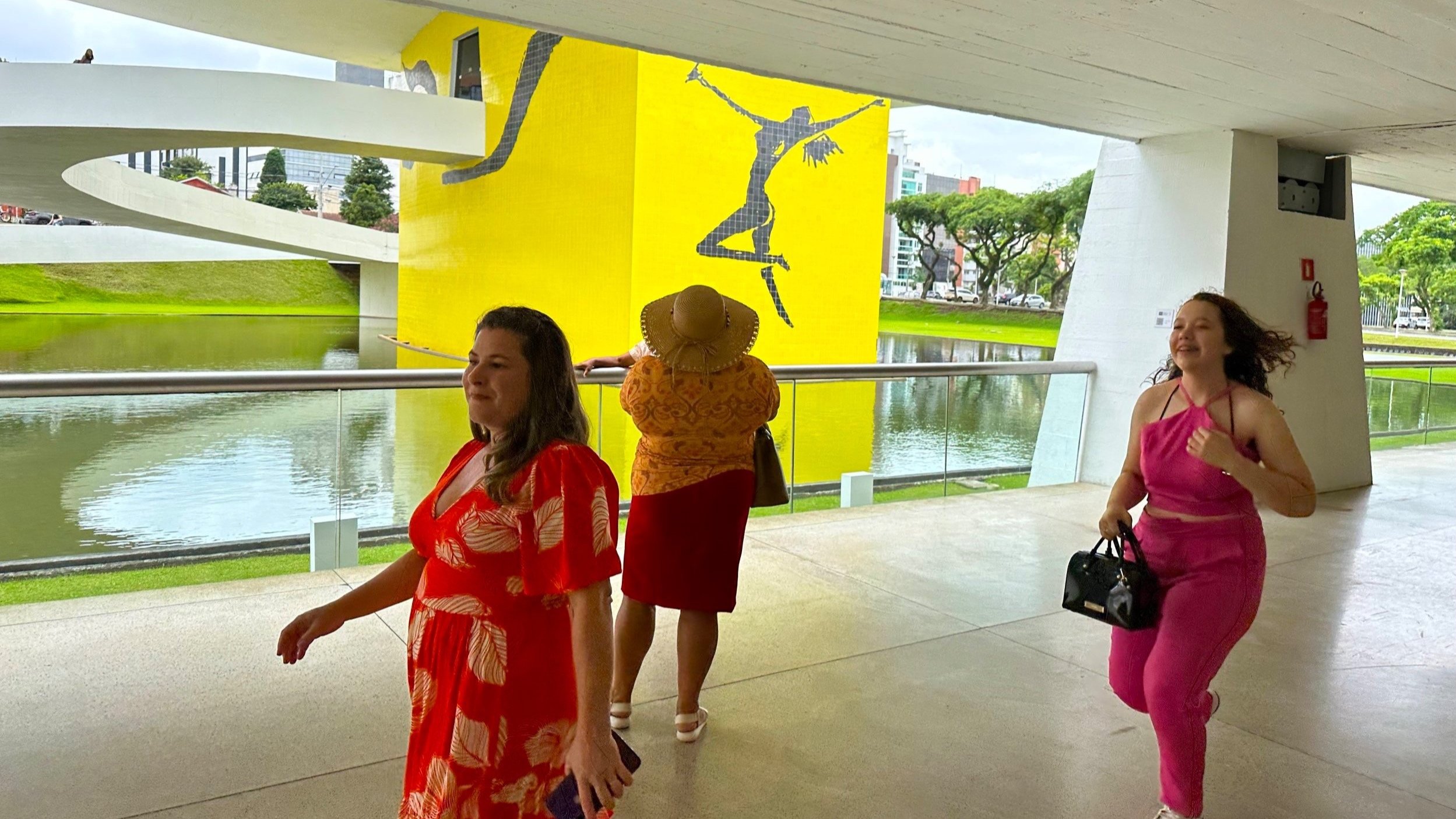Curitiba, the world's smartest city, knows that it is more than just about technology
The symbiotic relationship between people, nature, built environment and technology attracts people from all walks of life to Curitiba.
Curitiba, located in southern Brazil, is renowned for developing a multitude of creative civic and urban planning policies and strategies, that cumulatively demonstrate how urban systems can co-evolve with socio and ecological systems. These qualities were again recognised in 2023, when the Smart City World Expo Congress in Barcelona awarded Curitiba the title of the Smartest City in the world, acknowledging the city’s decades of prototyping transformational urban concepts balancing natural processes, human activity and built environment.
Beginning in the 1960s, Curitiba has developed parks rather than installed canals to mitigate flooding; implemented an integrated road and bus rapid transit system harmonized with land use; stimulated healthy urban food production and consumption; and initiated unique recycling schemes facilitating the exchange of cans, paper, glass, and electronics for fresh produce, benefiting thousands of low-income families.
Central to these transformative initiatives amongst others, is the Instituto de Pesquisa e Planejamento Urbano de Curitiba (IPPUC), an internationally acclaimed institution in the field of research, planning, and urban management. The IPPUC, under the visionary leadership of architect Jaime Lerner in its’ early days, has not only conceptualized ground-breaking ideas but also effectively translated them into tangible urban improvements. Lerner's optimistic philosophy, encapsulated in his statement that ‘the city is not a problem, it is a solution’, has resonated globally, as the institute's successful projects continue to inspire urban planning practices worldwide.
Over the years, the symbiotic relationship between IPPUC and city leadership has consistently proven fruitful. Mayors, including Cassio Taniguchi and the current incumbent, Rafael Greca, have worked at the Institute, strengthening the collaborative bond between IPPUC and the city's governance.
A smart city is an urban environment that uses different types of electronic methods and sensors to collect specific data to enhance the efficiency, and overall quality of life for its residents. Through the integration of interconnected digital infrastructure, smart cities collect and analyse real-time data to improve operations across the city, including transportation, energy, waste management, and public safety.
What is a Smart City?
In people-centric Curitiba, however, being smart isn't simply about integrating the latest technologies. Indeed, IT scholar Carla Cavichiolo Flores employed in the city’s Administration Secretary views technology not as an end in itself, but rather as a tool for citizens to actively contribute to civic life. While the architect Liana Valicelli, with 4 decades of service at IPPUC, underscores the city's commitment to placing people at the core of intricate urban planning decisions aiming to improve citizens’ quality of life.
A prime example of this is the Citizenship Streets initiative across Curitiba’s 16 districts, overseen by City Hall. These streets decentralise services, bringing the city centre experience to the heart of their neighbourhoods, providing residents with access to municipal, state and federal services, as well as commercial and recreational amenities.
The designation ‘Pinhão Valley’ is a tribute to the fruit of the land which is the pine nut, the fruit of the araucaria, the city's symbol tree.
The Pinhão Valley Innovation Ecosystem
Curitiba is known as a city to invest in. In recent years, the city has significantly streamlined the process of opening new businesses, reducing the average time to approximately two hours. This achievement is attributed to the seamless digital integration of services, reflecting a commitment to simplifying the entrepreneurial journey for those who want to start-up their innovative companies.
Many start-ups have found a home to incubate and grow within the innovation ecosystem Pinhão Valley. Drawing inspiration from Silicon Valley, the Pinhão Valley was established as a hub for Curitiba's emerging innovation ecosystem, attracting new tech companies to a former industrial site of the city. Fintech company EBANX, founded in 2012, is one of its’ success stories. Specialised in payment processing solutions for businesses looking to expand into Latin American markets, in seven years EBANX achieved unicorn status – a term used in the business world to describe a privately held start-up company with a valuation over $1 billion.
It is not only tech companies who have thrived within this innovation ecosystem, however. TROC, a virtual second-hand store that promotes high-end fashion sales within a circular economy perspective, owes its’ success to the thriving start-up culture associated with the Pinhão Valley. The company has made resale appealing to a broader customer base that may not have considered second-hand purchases before. Presently, TROC holds a catalogue of over 100 thousand unique pieces available for sale nationwide, contributing significantly to the extended use of clothing. Its success is instrumental in fostering a culture where clothing is viewed as durable rather than disposable.
Yet, when thinking of innovation ecosystems, a pertinent Hopi question arises: how does it grow corn? Well, Curitiba knows.
The Cajuru Urban Farm agroforestrty – when planning for a year, plant corn; when planning for a decade, plant trees; when planning for life, train and educate people.
Evolving Urban Food Systems for Nutrition
Dietary inequalities increase with income inequality. Curitiba has accumulated experience in developing nutrition-oriented food systems, whereby the social and health relevance of growing food in urban settings contributes to the quality of food consumed by its’ residents. For instance, the city's 147 vegetable gardens engages more than 37 thousand people directly and indirectly in cultivating tons of fresh, pesticide-free food annually.
For those who are not involved in growing food, the initiative Sacolão da Família (Family Big Basket) offers high-quality fruits and vegetables accessible to all citizens at a fixed per-kilo price, 40% lower than traditional retail, across 11 locations in Curitiba – R$ 3.99 (£0.64) per kilo.
The power to evolve food systems, whereby the social and health relevance of growing and foraging for food in urban settings contributes to cutting down food miles and decolonising our plates, is one of the leverage points identified by women in my book What if Women Designed the City?
The women spoke about re-establishing connections with the traditional ways of cultivating plants that grow in their localities. They referred to the potential of systematically allocating spaces in existing, abandoned and future developments for food and herbal cultivation. They also expressed their desire to expand existing growing activities to improve health, social connectivity, as well as reduce food miles and the cost of living.
Nossa Feira (Our Markert) is a programme addressing the challenge of balancing cost of living and healthy eating faced by low-income residents. It offers 40 different types of seasonal fruits and vegetables at a unique and affordable price in undersupplied regions. The initiative also plays a pivotal role in sustaining the livelihoods of family producers situated at the green belt of the municipality by establishing a guaranteed urban market for their produce.
The Cajuru Urban Farm, located on the site of a former car park, stands as an exemplary model for repurposing idle public spaces to address nutritional imbalances while recuperating the memory of traditional nutritional plants, known as PANC (non-conventional edible plants). Featuring an urban agro-forestry site with over 100 local species, the farm serves as an educational hub for those who want to lean and experience community gardening that deepens social links, encourages more diversified diets, minimises food miles, and promotes radical community healthcare.
Curitiba has a long history of pedestrianisation of streets but needs to do more to promote active travel.
What Challenges, Transforms
Despite possessing an innovative and well-functioning public transport system, Curitiba remains a car-dominated city. In February 2023, the city’s vehicle fleet reached the 1.5 million mark according to data from Paraná Traffic Department (DETRAN). Or expressed differently, it is as if there were 1.2 vehicles per inhabitant.
The company TomTom Global Traffic, specializing in traffic information, published its annual report that identifies the cities with the worst traffic issues in the world. The study is based on the level of urban congestion through cross-analysis between travel time and the distance to be covered. In the 2022 report, four Brazilian cities appear in the ranking that analyzed 390 cities around the world: Curitiba was in 37th place. This is reflected in the daily reality residents of the city experience, with IPPUC pointing out that Curitiba’s drivers spend, on average, 51 minutes a day in the car and that 62% of them mostly travel solo.
Curitiba has been smart in multiple ways. Celebrated for its innovative public transportation, waste management, urban food production and entrepreneurial spirit, making it one of Brazil's most successful and liveable cities. Yet, as the city continues to evolve, the once revolutionary system of transportation falls short and must be reinvented if the city is to reach its commitment to becoming a carbon neutral city by 2050.
Women play an important role in the history and administration of IPPUC. Nearly half of its workforce (46.5%) comprises women, occupying diverse roles, including technical and managerial positions. This may serve as an aspirational model for planning departments in other cities across the world. Urbanists at IPPUC listen closely to the evolving dynamics of their urban environment, infrastructure and citizenry, informing their approach to designing and developing city plans. The framework they use is rooted in a desire for inclusivity, an embodiment of care, and an acknowledgment of complexity. This is a city that strives more than most to balance head and heart.
Nearly half of the workforce at the internationally acclaimed 58-year-old Institute of research, planning, and urban management comprises women.
My book What if Women Designed the City? 33 leverage points to make your city work better for women and girls is out and can be ordered from Triarchy Press






